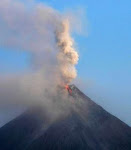
Brightest star explosion ever spotted
By SETH BORENSTEIN, AP Science Writer
A massive exploding faraway star — the brightest supernova astronomers have ever seen — has scientists wondering if a similar celestial fireworks show may light up the sky much closer to Earth sometime soon.
The discovery, announced Monday by NASA, drew oohs and aahs for months from the handful of astronomers who peered through telescopes to see the fuzzy remnants of the spectacular explosion after it was first spotted last fall.
Using a variety of Earth and space telescopes, astronomers found a giant exploding star that they figure has shined about five times brighter than any of the hundreds of supernovae ever seen before, said discovery team leader Nathan Smith of the University of California at Berkeley. The discovery was first made last September by a graduate student in Texas.
"This one is way above anything else," Smith told The Associated Press. "It's really astonishing."
Smith said the star, SN2006gy, "is a special kind of supernova that has never been seen before."
Observations from the Chandra X-ray telescope helped show that it didn't become a black hole like other supernovae and skipped a stage of star death.
Unlike other exploding stars, which peak at brightness for a couple of weeks at most, this supernova, peaked for 70 days, according to NASA. And it has been shining at levels brighter than other supernovae for several months, Smith said.
And even at 240 million light years away, this star in a distant galaxy does suggest that a similar and relatively nearby star — one 44 trillion miles away — might blow in similar fashion any day now or 50,000 years from now, Smith said. It wouldn't threaten Earth, but it would be visible to people in the Southern Hemisphere, he said.
+++++++++++++++
This star show was seen only last fall. Of course --- it has been travelling for the last 240 million years and it just arrived here on earth. This supernova might remain visible for another million years, which means that it no longer exist. What is visible are light remnants of the last million years. In the same breadth the stars we see now could be extinct already and what we see are the dying embers of a star that was. It is also possible that more stars are on their way to be seen, their starlight still travelling on their millions of light years journey to our planet.
It is not for man to worry. Man may not be around to witness any stars after a thousand years.


1 comment:
Star bright, Star Light....
I wish we can set
all good things right
in INANG BAYAN!
Cheers!
Post a Comment